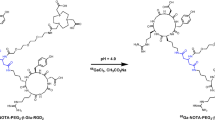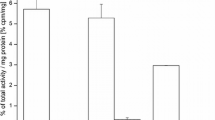Abstract
Purpose
One of the major obstacles of the clinical translation of 18F-labeled arginine-glycine-aspartic acid (RGD) peptides has been the laborious multistep radiosynthesis. In order to facilitate the application of RGD-based positron emission tomography (PET) probes in the clinical setting we investigated in this study the feasibility of using the chelation reaction between Al18F and a macrocyclic chelator-conjugated dimeric RGD peptide as a simple one-step 18F labeling strategy for development of a PET probe for tumor angiogenesis imaging.
Methods
Dimeric cyclic peptide E[c(RGDyK)]2 (RGD2) was first conjugated with a macrocyclic chelator, 1,4,7-triazacyclononane-1,4,7-triacetic acid (NOTA), and the resulting bioconjugate NOTA-RGD2 was then radiofluorinated via Al18F intermediate to synthesize 18F-AlF-NOTA-RGD2. Integrin binding affinities of the peptides were assessed by a U87MG cell-based receptor binding assay using 125I-echistatin as the radioligand. The tumor targeting efficacy and in vivo profile of 18F-AlF-NOTA-RGD2 were further evaluated in a subcutaneous U87MG glioblastoma xenograft model by microPET and biodistribution.
Results
NOTA-RGD2 was successfully 18F-fluorinated with good yield within 40 min using the Al18F intermediate. The IC50 of 19F-AlF-NOTA-RGD2 was determined to be 46 ± 4.4 nM. Quantitative microPET studies demonstrated that 18F-AlF-NOTA-RGD2 showed high tumor uptake, fast clearance from the body, and good tumor to normal organ ratios.
Conclusion
NOTA-RGD2 bioconjugate has been successfully prepared and labeled with Al18F in one single step of radiosynthesis. The favorable in vivo performance and the short radiosynthetic route of 18F-AlF-NOTA-RGD2 warrant further optimization of the probe and the radiofluorination strategy to accelerate the clinical translation of 18F-labeled RGD peptides.






Similar content being viewed by others
References
Brooks PC, Montgomery AM, Rosenfeld M, Reisfeld RA, Hu T, Klier G, et al. Integrin αvβ3 antagonists promote tumor regression by inducing apoptosis of angiogenic blood vessels. Cell 1994;79:1157–64.
Chiang AC, Massagué J. Molecular basis of metastasis. N Engl J Med 2008;359:2814–23.
Klein CA. Cancer. The metastasis cascade. Science 2008;321:1785–7.
Podsypanina K, Du YC, Jechlinger M, Beverly LJ, Hambardzumyan D, Varmus H. Seeding and propagation of untransformed mouse mammary cells in the lung. Science 2008;321:1841–4.
Kumar CC. Integrin αvβ3 as a therapeutic target for blocking tumor-induced angiogenesis. Curr Drug Targets 2003;4:123–31.
Jacobson O, Zhu L, Niu G, Weiss ID, Szajek LP, Ma Y, et al. MicroPET imaging of integrin α(v)β(3) expressing tumors using (89)Zr-RGD peptides. Mol Imaging Biol 2010.
Haubner R, Beer AJ, Wang H, Chen X. Positron emission tomography tracers for imaging angiogenesis. Eur J Nucl Med Mol Imaging 2010;37 Suppl 1:S86–103.
Coenen HH, Elsinga PH, Iwata R, Kilbourn MR, Pillai MR, Rajan MG, et al. Fluorine-18 radiopharmaceuticals beyond [18F]FDG for use in oncology and neurosciences. Nucl Med Biol 2010;37:727–40.
Haubner R, Wester HJ, Weber WA, Mang C, Ziegler SI, Goodman SL, et al. Noninvasive imaging of αvβ3 integrin expression using 18F-labeled RGD-containing glycopeptide and positron emission tomography. Cancer Res 2001;61:1781–5.
Beer AJ, Haubner R, Goebel M, Luderschmidt S, Spilker ME, Wester HJ, et al. Biodistribution and pharmacokinetics of the αvβ3-selective tracer 18F-galacto-RGD in cancer patients. J Nucl Med 2005;46:1333–41.
Haubner R, Weber WA, Beer AJ, Vabuliene E, Reim D, Sarbia M, et al. Noninvasive visualization of the activated αvβ3 integrin in cancer patients by positron emission tomography and [18F]Galacto-RGD. PLoS Med 2005;2:e70.
Morrison MS, Ricketts SA, Barnett J, Cuthbertson A, Tessier J, Wedge SR. Use of a novel Arg-Gly-Asp radioligand, 18F-AH111585, to determine changes in tumor vascularity after antitumor therapy. J Nucl Med 2009;50:116–22.
McParland BJ, Miller MP, Spinks TJ, Kenny LM, Osman S, Khela MK, et al. The biodistribution and radiation dosimetry of the Arg-Gly-Asp peptide 18F-AH111585 in healthy volunteers. J Nucl Med 2008;49:1664–7.
Kenny LM, Coombes RC, Oulie I, Contractor KB, Miller M, Spinks TJ, et al. Phase I trial of the positron-emitting Arg-Gly-Asp (RGD) peptide radioligand 18F-AH111585 in breast cancer patients. J Nucl Med 2008;49:879–86.
Wu Z, Li ZB, Cai W, He L, Chin FT, Li F, et al. 18F-labeled mini-PEG spacered RGD dimer (18F-FPRGD2): synthesis and microPET imaging of αvβ3 integrin expression. Eur J Nucl Med Mol Imaging 2007;34:1823–31.
Poethko T, Schottelius M, Thumshirn G, Hersel U, Herz M, Henriksen G, et al. Two-step methodology for high-yield routine radiohalogenation of peptides: (18)F-labeled RGD and octreotide analogs. J Nucl Med 2004;45:892–902.
Cai W, Zhang X, Wu Y, Chen X. A thiol-reactive 18F-labeling agent, N-[2-(4-18F-fluorobenzamido)ethyl]maleimide, and synthesis of RGD peptide-based tracer for PET imaging of αvβ3 integrin expression. J Nucl Med 2006;47:1172–80.
Höhne A, Mu L, Honer M, Schubiger PA, Ametamey SM, Graham K, et al. Synthesis, 18F-labeling, and in vitro and in vivo studies of bombesin peptides modified with silicon-based building blocks. Bioconjug Chem 2008;19:1871–9.
Höhne A, Yu L, Mu L, Reiher M, Voigtmann U, Klar U, et al. Organofluorosilanes as model compounds for 18F-labeled silicon-based PET tracers and their hydrolytic stability: experimental data and theoretical calculations (PET = positron emission tomography). Chemistry 2009;15:3736–43.
Ting R, Harwig C, auf dem Keller U, McCormick S, Austin P, Overall CM, et al. Toward [18F]-labeled aryltrifluoroborate radiotracers: in vivo positron emission tomography imaging of stable aryltrifluoroborate clearance in mice. J Am Chem Soc 2008;130:12045–55.
Laverman P, McBride WJ, Sharkey RM, Eek A, Joosten L, Oyen WJ, et al. A novel facile method of labeling octreotide with (18)F-fluorine. J Nucl Med 2010;51:454–61.
McBride WJ, D’Souza CA, Sharkey RM, Karacay H, Rossi EA, Chang CH, et al. Improved 18F labeling of peptides with a fluoride-aluminum-chelate complex. Bioconjug Chem 2010;21:1331–40.
McBride WJ, Sharkey RM, Karacay H, D’Souza CA, Rossi EA, Laverman P, et al. A novel method of 18F radiolabeling for PET. J Nucl Med 2009;50:991–8.
Wu Y, Zhang X, Xiong Z, Cheng Z, Fisher DR, Liu S, et al. microPET imaging of glioma integrin αvβ3 expression using (64)Cu-labeled tetrameric RGD peptide. J Nucl Med 2005;46:1707–18.
Liu S, Liu Z, Chen K, Yan Y, Watzlowik P, Wester HJ, et al. 18F-labeled galacto and PEGylated RGD dimers for PET imaging of αvβ3 integrin expression. Mol Imaging Biol 2010;12:530–8.
Cheng Z, Wu Y, Xiong Z, Gambhir SS, Chen X. Near-infrared fluorescent RGD peptides for optical imaging of integrin αvβ3 expression in living mice. Bioconjug Chem 2005;16:1433–41.
Mittra E, Goris ML, Lagaru AH, Kardan A, Burton L, Berganos R, et al. Pilot pharmacokinetic and dosimetric studies of [18F]FPPRGD2: a PET radiopharmaceutical agent for imaging αvβ3 integrin levels. Radiology. In press 2011.
de Bruin B, Kuhnast B, Hinnen F, Yaouancq L, Amessou M, Johannes L, et al. 1-[3-(2-[18F]fluoropyridin-3-yloxy)propyl]pyrrole-2,5-dione: design, synthesis, and radiosynthesis of a new [18F]fluoropyridine-based maleimide reagent for the labeling of peptides and proteins. Bioconjug Chem 2005;16:406–20.
Jiang L, Kimura RH, Miao Z, Silverman AP, Ren G, Liu H, et al. Evaluation of a (64)Cu-labeled cystine-knot peptide based on agouti-related protein for PET of tumors expressing αvβ3 integrin. J Nucl Med 2010;51:251–8.
Chen X, Park R, Tohme M, Shahinian AH, Bading JR, Conti PS. MicroPET and autoradiographic imaging of breast cancer alpha v-integrin expression using 18F- and 64Cu-labeled RGD peptide. Bioconjug Chem 2004;15:41–9.
Li ZB, Cai W, Cao Q, Chen K, Wu Z, He L, et al. (64)Cu-labeled tetrameric and octameric RGD peptides for small-animal PET of tumor αvβ3 integrin expression. J Nucl Med 2007;48:1162–71.
Acknowledgement
This work was supported, in part, by NCI 5R01 CA119053 (ZC) and In vivo Cellular Molecular Imaging Center (ICMIC) grant P50 CA114747 (SSG).
Conflicts of interest
None.
Author information
Authors and Affiliations
Corresponding author
Additional information
Shuanglong Liu and Hongguang Liu contributed equally to the work.
Rights and permissions
About this article
Cite this article
Liu, S., Liu, H., Jiang, H. et al. One-step radiosynthesis of 18F-AlF-NOTA-RGD2 for tumor angiogenesis PET imaging. Eur J Nucl Med Mol Imaging 38, 1732–1741 (2011). https://doi.org/10.1007/s00259-011-1847-4
Received:
Accepted:
Published:
Issue Date:
DOI: https://doi.org/10.1007/s00259-011-1847-4




